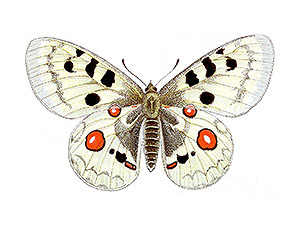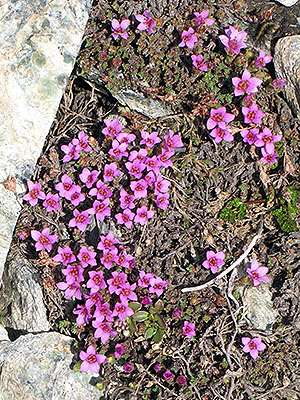Fichtel Mountain (Parnassius apollo ssp. ancile)
This form was described in 1909, apparently already after its extinction; it was restricted to a small region around the city of Bad Berneck in the Franconian part of the Fichtel Mountains.
The reasons for its disappearance are very well known.:
“P. apollo ancile Fruhst, von Berneck im Fichtelgebirge hat leider dasselbe tragische Schicksal wie P. apollo posthumus erreicht. An der einzigen Stelle des Fichtelgebirges, wo ancile vorkam, wurde er nach freundl. brieflichen Mitteilungen des Herrn Lehrers Poehlmann in Röhrenhof, Oberfranken, durch „brutales Wegfangen seitens der Sommerfrischler, noch mehr aber durch die Dummheit einer Gärtnersfrau, völlig ausgerottet. Letztere ließ die ancile durch Kinder einfangen, um die apollo den abreisenden Kurgästen auf das übliche Blumenbuket (noch dazu häufig lebend!) zu stecken. 1909 wurde das letzte Stück beobachtet. Ein bezirksamtliches Fangverbot kam zu spät, es gab nichts mehr zu schützen.” [1]
translation:
“P. apollo ancile Fruhst, from Berneck in the Fichtel mountains unfortunately met the same tragic fate as P. apollo posthumus. In the only place in the Fichtel Mountains where ancile occurred, it was found, according to a friendly written message by the teacher Poehlmann in Hülsenhof, Upper Franconia, completely eradicated by “brutal capture by the summer visitors, but even more so by the stupidity of a gardener’s wife. The latter had the ancile captured by children in order to pin the apollo on the usual bouquet of flowers (and often alive!) for the departing spa guests. The last specimen was observed in 1909. A district official catching ban came too late; there was nothing left to protect.”
*********************

Depiction from: ‘Jacob Hübner: Das kleine Schmetterlingsbuch: Die Tagfalter, Insel-Bücherei Nr. 213. 1934’
(public domain)
*********************
References:
[1] H. Fruhstorfer: Neue und seltene Parnassius-Rassen. Entomologischer Anzeiger 3(11): 131-133. 1923
*********************
edited: 10.01.2024

